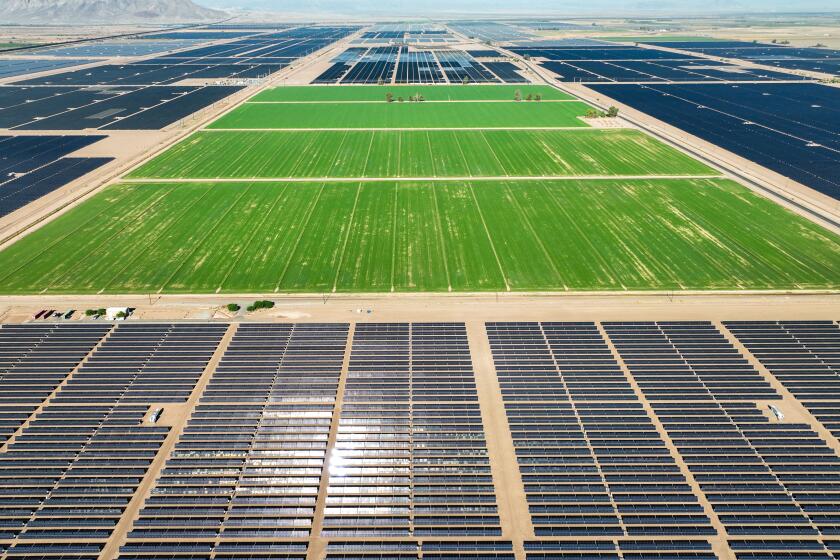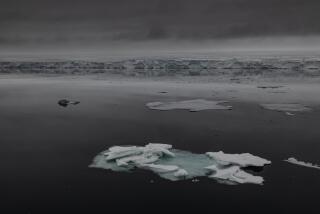New ice core analysis shows Greenland rapidly warming

- Share via
A sharp rise in Greenland temperatures since 1995 showed the giant northern island 2.7 degrees higher than its 20th century average, the highest in more than 1,000 years, according to new ice core data.
Until now Greenland ice cores — a glimpse into long-running temperatures before thermometers — hadn’t shown much of a clear signal of global warming on the remotest north-central part of the island, at least compared with the rest of the world.
But the ice cores also hadn’t been updated since 1995. Newly analyzed cores, drilled in 2011, show a dramatic rise in temperature in the previous 15 years, according to a study in Wednesday’s journal Nature.
“We keep on [seeing] rising temperatures between 1990s and 2011,” said study lead author Maria Hoerhold, a glaciologist at the Alfred Wegener Institute in Germany. “We have now a clear signature of global warming.”
It takes years to analyze ice core data. Hoerhold has new cores from 2019 but hasn’t finished studying them yet. She expects to see continued temperature rise, as Greenland’s ice sheet and glaciers have been melting faster recently.
Global warming is making it harder to solve global warming. But there’s cause for hope.
“This is an important finding and corroborates the suspicion that the ‘missing warming’ in the ice cores is due to the fact that the cores end before the strong warming sets in,” said climate scientist Martin Stendel of the Danish Meteorological Institute, who wasn’t part of the research.
The ice cores are used to make a chart of proxy temperatures for Greenland running from the year 1000 to 2011. It shows temperatures gently sloping lower for
the first 800 years, then wiggling up and down while sloping higher until a spike even higher from the 1990s on.
One scientist compared it to a hockey stick, a description used for other long-term temperature data showing climate change.
The jump in temperature after 1995 is so much larger than in preindustrial times before the mid-19th century that there is “almost zero” chance that it is anything but human-caused climate change, Hoerhold said.
The warming spike also mirrors a sudden rise in the amount of water running off from Greenland’s melting ice, the study finds.
What had been happening in Greenland is that natural weather variability, undulations because of an occasional weather system called Greenland blocking, in the past had masked human-caused climate change, Hoerhold said.
Replacing agriculture with solar panels could help solve the West’s energy and water crises. But farmers are fighting back.
But as of about 25 years ago, the warming became too big to be hidden, she said.
Past data also showed Greenland not warming as fast as the rest of the Arctic, which is now warming four times faster than the global average. But the island appears to be catching up.
Ice core data for years showed Greenland acted a bit differently from the Arctic. That’s probably because of Greenland blocking, Hoerhold said.
Other scientists said as a giant land mass Greenland was less affected by melting sea ice and other water factors compared with the rest of the Arctic, which is much more water-adjacent.
Hoerhold’s team drilled five new cores near old cores so as to match established ice core records. They use the difference between two types of oxygen isotopes found in the ice to calculate temperature, using an already established formula that is checked against observed data.
Let’s use this Thanksgiving as an opportunity for optimism on climate change.
Hoerhold and outside scientists said the new warming data are bad news because Greenland’s ice sheet is melting. In fact, the study ends with data from 2011 and the next year had a record melt across Greenland and the island’s ice loss has been on high since then, she said.
“We should be very concerned about North Greenland warming because that region has a dozen sleeping giants in the form of wide tidewater glaciers and an ice stream,” said Danish Meteorological Institute ice scientist Jason Box. And when awakened, it will ramp up melt from Greenland, he said.
And that means “rising seas that threaten homes, businesses, economies and communities,” said U.S. National Snow and Ice Data Center deputy lead scientist Twila Moon.
More to Read
Toward a more sustainable California
Get Boiling Point, our newsletter exploring climate change, energy and the environment, and become part of the conversation — and the solution.
You may occasionally receive promotional content from the Los Angeles Times.













